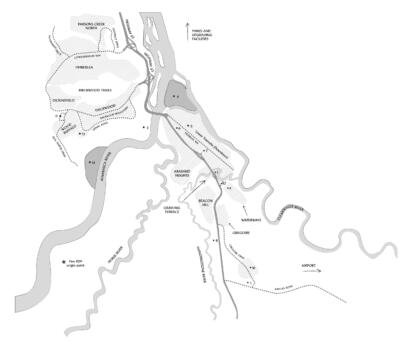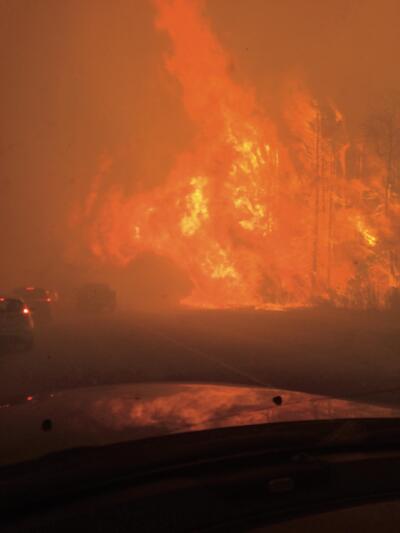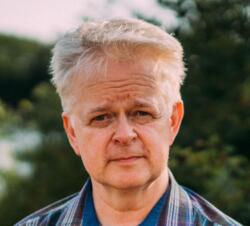1956 The fire dragon
Fire Weather: The Making of a Beast
by John Vaillant
Toronto: Alfred A. Knopf Canada, 2023
$38.00 / 9780735273160
Reviewed by Trevor Marc Hughes
*
 John Vaillant opens his book with a quote from the fire chief of Fort McMurray, Alberta: “No one’s ever seen anything like this…this is rewriting the book.” We are soon launched into a book where none of the old rules apply.
John Vaillant opens his book with a quote from the fire chief of Fort McMurray, Alberta: “No one’s ever seen anything like this…this is rewriting the book.” We are soon launched into a book where none of the old rules apply.
This is, quite frankly, a staggering book. It is a collection of revelations, where Vaillant describes the boreal forest, a massive expanse which he calls “the largest terrestrial ecosystem.” It covers a third of Canada. But even more explosive than that is his claim that those trees were designed to burn down. And Fort McMurray is surrounded by many, many of them, and is the centre “of the largest, most expensive, most energy-intensive hydrocarbon recovery project on Earth.” Massive amounts of investment money have been focussed on it, and many people, who are paid very well, have homes there.
What could go wrong?

Fort McMurray has a unique, seemingly inexhaustible feature, it’s “where bitumen forms a black and sandy stratum through the river valley.” Vaillant tracks the extraordinary rise of the petroleum industry, which has shades of the current deflating real estate boom, and cannot be fully described without pointing out peculiarities in human psychology that come with the perception of abundance. He compares the petroleum industry to the historic monopoly enjoyed by the Hudson’s Bay Company, where “free rein” is hard to distinguish from “free reign.” This exuberance of not only the people who control the industry, but those that make a good living from it, is what Vaillant compares with fire itself. We are not so different from fire, we humans. It wishes “to exist, to consume, to grow, to flourish,” as did the people of Fort McMurray before May 2016 with their expensive homes, vehicles, and belongings, fuelled by their large pay cheques. But since what Vaillant refers to as the Petrocene Age began, there have been increasingly more chances for fire to propagate and be fruitful, especially in the unique place, time and conditions Fort McMurray found itself in in May 2016.

We have become dependent on fire, Vaillant argues. We are dependent on the spark, the combustion, that causes vehicles to fire into life. Those fuel combustion engines generate little contained fires. What do we need that fire needs to survive? Oxygen. Imagine how long you would last without it, Vaillant asks his readers. We are more similar to fire than we care to admit, so much so that Vaillant has renamed us. Homo sapiens, in his view, would be more appropriately named Homo flagrans: burning man.
The revelations keep on coming, making this book as hard to put down as an engrossing novel, yet this is not fiction. The massive fire that took place in Fort McMurray, even considering its size, scope, and length of burn, was not an isolated incident. The frequency increases. “Across North America, and around the world,” Vaillant writes, “fires are burning over longer seasons and with greater intensity than at any other time in human history.” Does this mean, as the author theorizes, we are entering the Century of Fire? We only need turn on the news to find out.

Where Vaillant shines, beyond shocking us with what we already know, is in how he portrays the inability of the people of Fort McMurray to recognize the wall of flame coming towards them. The one example that stands out for me is, despite the aggressive fire coming towards her, a successful professional woman decides to bring in her dry cleaning as usual. The dry cleaner, who just learned that the fire is out of control and heading straight towards him, takes in the dry cleaning custom and says to the woman: “Tuesday good?”

Vaillant, through many interviews, documents many people who are in denial while forced to evacuate the place they call home. He also compares the free market capitalism of the Alberta bitumen industry with a fire at the crossover point, where it becomes manic, improvisational, unstoppable. His chronicling of the day of the fire’s approach is incredibly detailed and well-researched. But ultimately, Vaillant succeeds in portraying the irony of the situation faced by the people in Fort McMurray in May 2016. He shows “that same combustive energy that thrilled, empowered, and enriched them was now manifesting itself in the most primal, potent, and destructive way imaginable.” What followed was a throwing out of the rule book as fire behaved in ways previously not seen.
A section of the book fleshes out the extent to which climate scientists pursued work in understanding, and conveying to a public unwilling to understand, the “greenhouse effect.” Many of those scientists were vilified, smacked down in sometimes cruel, horrifying ways.
The collection of anthropogenic carbon dioxide that has been building is having “a major effect on the climate of the Earth.” What those early scientists pointed out, as future events, is now taking place.
With images of this summer’s fire in Lahaina fresh in mind, wildfires in increasingly unlikely places are happening. Vaillant’s book is a must read to understand, not only why, but why human beings continue to look the other way.
 *
*

Trevor Marc Hughes has written several books and many articles about his motorcycle travels across British Columbia. He edited Riding the Continent, Hamilton Mack Laing’s account of his 1915 ride on a Harley-Davidson 11-F across the continental United States. He’s the author of Capturing the Summit: Hamilton Mack Laing and the Mount Logan Expedition of 1925. He is currently the interim non-fiction editor for The British Columbia Review and recently reviewed books by Peter Rowlands and Daniel Arnold, Darrell Dennis, & Medina Hahn.
*
The British Columbia Review
Interim Editors, 2023-24: Trevor Marc Hughes (non-fiction), Brett Josef Grubisic (fiction)
Publisher: Richard Mackie
Formerly The Ormsby Review, The British Columbia Review is an on-line book review and journal service for BC writers and readers. The Advisory Board now consists of Jean Barman, Wade Davis, Robin Fisher, Barry Gough, Hugh Johnston, Kathy Mezei, Patricia Roy, Maria Tippett, and Graeme Wynn. Provincial Government Patron (since September 2018): Creative BC. Honorary Patron: Yosef Wosk. Scholarly Patron: SFU Graduate Liberal Studies. The British Columbia Review was founded in 2016 by Richard Mackie and Alan Twigg.
“Only connect.” – E.M. Forster
7 comments on “1956 The fire dragon”
An important book and a great review Trevor. We’re hoping to attract John to our next Denman Island Readers and Writers Festival. Not that there is any danger of wild fire on Denman Island. But we’re still part of the outside world, sort of. And out there, this tar sands industrial complex (along with its UCP cheerleaders) leads an increasingly staunch resistance to any effective, sincere, sustained Canadian response to the climate crisis. So it’s good to know a bit more about them, and how they manage to remain in denial even as the crisis approaches their mines and big homes and shiny new F150s.